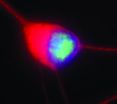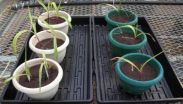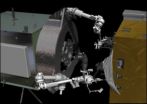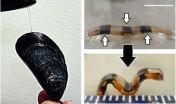(Press-News.org) Improving radiation therapies for cancer mathematically
In a paper published in December in the SIAM Journal on Scientific Computing, authors Li-Tien Cheng, Bin Dong, Chunhua Men, Xun Jia, and Steve Jiang propose a method to optimize radiation therapy treatments in cancer patients.
Radiation therapy is one of the primary methods used for cancer treatment, along with chemotherapy and surgery. While doses of radiation are delivered to eliminate cancerous tissue, care is taken to keep radiation within acceptable levels so as not to affect neighboring tissues and organs. The most common type of therapy delivers high-energy radiation via a medical linear accelerator mounted on a rotating apparatus to adjust the direction, and a collimator to shape the beam of radiation. In the recently developed volumetric modulated arc therapy (VMAT), beams continuously deliver doses as the delivery device rotates around the patient. Enhancement of radiotherapy treatment is challenged by complexities of shape optimization, due to the mechanics of the equipment involved as well as the apertures of devices delivering the beams of radiation.
In this paper, the authors develop a variational model and associated numerical techniques for optimization of VMAT treatment plans. The method uses CT scans of patients—with important tissues and organs identified by image segmentation algorithms—to create an improved and customized treatment plan by constructing parameters for an optimal dose distribution in VMAT treatment. Mathematical methods such as binary level-set method for shape optimization are used. Tests have shown improved dose distributions in both model and clinical cases.
Binary Level-Set Shape Optimization Model and Algorithm for Volumetric Modulated Arc Therapy in Radiotherapy Treatment
SIAM Journal on Scientific Computing, 35(6), B1321–B1340
Evaluating climate models
The simulation of elements affecting the Earth's climate is usually carried out by coupled atmosphere-ocean circulation models, output from which is used to provide insights into future climate states. Climate models have traditionally been assessed by comparing summary statistics (such as global annual mean temperatures) or point estimates from simulated models to the corresponding observed quantities.
A paper published last December in the SIAM/ASA Journal on Uncertainty Quantification argues that it is more appropriate to compare the distribution of climate model output data (over time and space) to the corresponding distribution of observed data. Distance measures between probability distributions, also called divergence functions, can be used to make this comparison.
The authors evaluate 15 different climate models by comparing simulations of past climate to corresponding reanalysis data. Reanalysis datasets are created by inputting climate observations using a given climate model throughout the entire reanalysis period in order to reduce the effects of modeling changes on climate statistics. Historical weather observations are used to reconstruct atmospheric states on a global grid, thereby allowing direct comparison to climate model output.
View the paper:
Using Proper Divergence Functions to Evaluate Climate Models
SIAM/ASA Journal on Uncertainty Quantification, 1, 522-534
Math models analyze long-term criminal activity patterns in a population
In a paper published last November in Multiscale Modeling and Simulation: A SIAM Interdisciplinary Journal, authors Henri Berestycki, Nancy Rodríguez, and Lenya Ryzhik show that the assumption of a population's natural tendency towards crime significantly changes long-term criminal activity patterns. The authors use a reaction-diffusion system to study criminal activity. A reaction-diffusion model of a system describes how components of a system interact (in this case population zones and criminals) and predict how one or more of the components (in this case criminals) move in space and time. Reaction-diffusion models have traveling wave solutions where the waveform is a function of a single variable and the wave travels at a constant speed. The authors show that traveling wave solutions of such a model connect zones with no criminal activity with zones of high criminal activity (or hotspots). This corresponds to an invasion of criminal activity into all space. The paper studies the problem of preventing such invasions by employing a finite number of resources that reduce payoff for committing a crime, as well as characterizes the minimum amount of resources necessary to prevent invasion of criminal activity.
While it is natural to expect that in a population with a natural tendency toward crime—based on motivation, opportunity, and running average of crime in an area— a criminal hot or warm spot might form, the authors find an interesting observation in populations with indifference or zero tendency toward criminal activity. In cases where there is indifference, criminal activity begins to dominate with a high enough payoff. Lack of crime here is a steady state, but when it becomes unstable, criminal activity begins to dominate. In the case of populations with a natural tendency to be peaceful or crime-free, there is an interesting interplay between natural tendency and payoff for committing a crime. Here there are three steady states: complete lack of crime, small amount of crime, or a hotspot. Since small amount of crime is usually unstable, the population tends toward either zero crime or a hotspot in the long run.
View the paper:
Traveling Wave Solutions in a Reaction-Diffusion Model for Criminal Activity
Multiscale Modeling & Simulation, 11(4), 1097-1126
Mathematically correcting over- and underexposure in photographs
Almost anyone with a camera or smartphone is sure to have noticed that taking pictures in bright conditions, such as a sunny day, can cause a loss of highlight details (or overexposure) in bright regions and a loss of shadow details (or underexposure) in dark regions. A paper published last November in the SIAM Journal on Imaging Science attempts to overcome these photography woes.
In digital photography, "exposure" controls how much light reaches the image sensor and the lightness of the photograph is determined by the amount of light shown. There is a physical limit on the lightness contrast, or separation between the darkest and brightest areas of an image that a camera can capture (called the dynamic range). An outdoor scene with bright or harsh lighting conditions has a much higher dynamic range than the capacity of a regular image sensor—this results in loss of highlight and shadow details.
In their paper aptly titled "Recovering Over-/Underexposed Regions in Photographs," authors Likun Hou, Hui Ji, and Zuowei Shen present a new wavelet frame-based approach for correcting pixels that are affected by over- and underexposure in photographs. Generic color image restoration techniques like image inpainting and contrast enhancement are not optimized to correct over- and underexposure in digital photography. Hence, the authors use color image restoration methods specifically designed for overexposure correction, which simultaneously correct over- and underexposed regions.
The problem of over-/underexposure is broken down and resolved as three sub-problems: the first is an inpainting problem which recovers the lightness value of over-/underexposed pixels, which are clipped to fit the dynamic range. The second problem deals with adjusting the lightness of the whole image to fit the range while revealing more image details of the darker regions. Third, missing chromatic details of overexposed pixels are recovered from information provided by neighboring well-exposed pixels.
View the paper:
Recovering Over-/Underexposed Regions in Photographs
SIAM Journal on Imaging Sciences, 6(4), 2213-2235
INFORMATION: END
Applying math to cancer, climate, crime and cameras
2014-03-05
ELSE PRESS RELEASES FROM THIS DATE:
3-D changes in DNA may lead to a genetic form of Lou Gehrig's disease
2014-03-05
New findings reveal how a mutation, a change in the genetic code that causes neurodegeneration, alters the shape of DNA, making cells more vulnerable to stress and more likely to die.
The particular mutation, in the C9orf72 gene, is the most common cause for amyotrophic lateral sclerosis (ALS, also known as Lou Gehrig's disease), and frontotemporal degeneration (FTD), the second most common type of dementia in people under 65.
This research by Jiou Wang, Ph.D., and his colleagues at Johns Hopkins University (JHU) was published in Nature and was partially funded by ...
Look back at US soybeans shows genetic improvement behind increased yields
2014-03-05
URBANA, Ill. – Soybean improvement through plant breeding has been critical over the years for the success of the crop. In a new study that traces the genetic changes in varieties over the last 80 years of soybean breeding, researchers concluded that increases in yield gains and an increased rate of gains over the years are largely due to the continual release of greater-yielding cultivars by breeders.
"This research in some ways looks back and informs us how soybean varieties have changed. It's useful to document these traits and changes," said Brian Diers, a University ...
Fertility prospects following ectopic pregnancy
2014-03-05
WINSTON-SALEM, N.C. – March 5, 2014 – Preserving a fallopian tube following an ectopic pregnancy seems like it would favor a woman's fertility prospects, right?
A new study from Wake Forest Baptist Medical Center looked at pregnancy outcomes in regards to the two surgical treatments for ectopic pregnancy -- salpingectomy, in which the affected fallopian tube is removed, or salpingotomy, in which the tube is preserved.
The aim of the study, said co-author Tamer Yalcinkaya, M.D., a reproductive endocrinologist at Wake Forest Baptist, was to assess whether salpingotomy ...
Maize and bacteria: A 1-2 punch knocks copper out of stamp sand
2014-03-05
Scientists have known for years that together, bacteria and plants can remediate contaminated sites. Ramakrishna Wusirika, of Michigan Technological University, has determined that how you add bacteria to the mix can make a big difference.
He has also shed light on the biochemical pathways that allow plants and bacteria to clean up some of the worst soils on the planet while increasing their fertility.
Wusirika, an associate professor of biological sciences, first collected stamp sands near the village of Gay, in Michigan's Upper Peninsula. For decades, copper mining ...
NASA tests new robotic refueling technologies
2014-03-05
NASA has successfully concluded a remotely controlled test of new technologies that would empower future space robots to transfer hazardous oxidizer – a type of propellant – into the tanks of satellites in space today.
Concurrently on the ground, NASA is incorporating results from this test and the Robotic Refueling Mission on the International Space Station to prepare for an upcoming ground-based test of a full-sized robotic servicer system that will perform tasks on a mock satellite client.
Collectively, these efforts are part of an ongoing and aggressive technology ...
OU study suggests non-uniform climate warming global
2014-03-05
A recent University of Oklahoma study of five decades of satellite data, model simulations and in situ observations suggests the impact of seasonal diurnal or daily warming varies between global regions affecting many ecosystem functions and services, such as food production, carbon sequestration and climate regulation. The effects of non-uniform climate warming on terrestrial ecosystems is a key challenge in carbon cycle research and for those making future predictions.
Jianyang Xia, a research associate in the OU College of Arts and Sciences, says the impact of non-uniform ...
A small step toward discovering habitable earths
2014-03-05
University of Arizona researchers snapped images of a planet outside our solar system with an Earth-based telescope using essentially the same type of imaging sensor found in digital cameras instead of an infrared detector. Although the technology still has a very long way to go, the accomplishment takes astronomers a small step closer to what will be needed to image earth-like planets around other stars
"This is an important next step in the search for exoplanets because imaging in visible light instead of infrared is what we likely have to do if we want to detect planets ...
Researchers find potential target for drug to treat allergic asthma
2014-03-05
COLUMBUS, Ohio – An enzyme that helps maintain immune system function by "throwing away" a specific protein has a vital role in controlling symptoms of allergic asthma, new research in mice suggests.
The finding suggests that this enzyme, called Cbl-b, could be a target for drugs used to treat allergic asthma and other autoimmune disorders.
This new study, led by Ohio State University researchers, is the first to link Cbl-b to allergic asthma in an animal model.
The findings parallel results from a 2012 Yale study in humans, which suggested that a mutation in the ...
Pumping iron: A hydrogel actuator with mussel tone
2014-03-05
Protein from a small, tasty mollusk inspired Michigan Technological University's Bruce P. Lee to invent a new type of hydrogel actuator.
Hydrogels are soft networks of polymers with high water content, like jello. Because of their soft, gentle texture, they have the potential to interact safely with living tissues and have applications in a number of medical areas, including tissue engineering. Lee, an assistant professor of biomedical engineering, wanted to make a hydrogel that wouldn't just sit there.
"Hydrogels that can change shape on command could be used to deliver ...
Going viral to target tumors
2014-03-05
March 5, 2014, New York, NY– A Ludwig Cancer Research study suggests that the clinical efficacy of checkpoint blockade, a powerful new strategy to harness the immune response to treat cancers, might be dramatically improved if combined with oncolytic virotherapy, an investigational intervention that employs viruses to destroy tumors.
Published today in the journal Science Translational Medicine, the study evaluated a combination therapy in which the Newcastle disease virus (NDV), a bird virus not ordinarily harmful to humans, is injected directly into one of two melanoma ...




